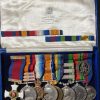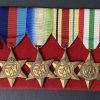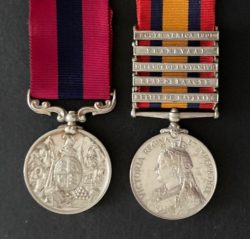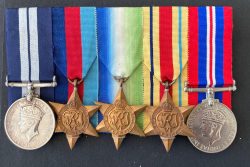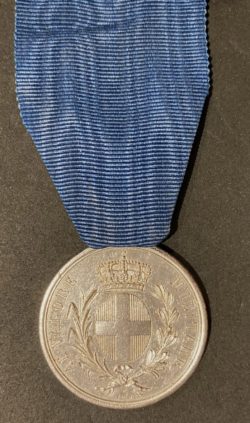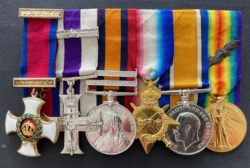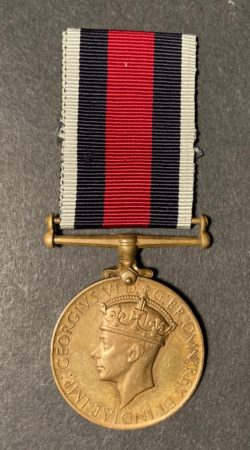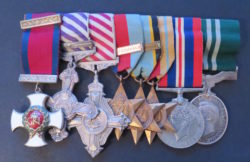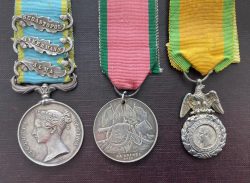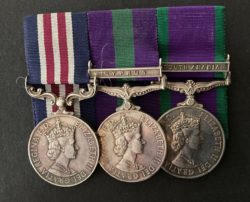Exceptional Great War Distinguished Flying Medal and French Medaille Militaire group Sergeant L.A. Allen, No.2. Naval Squadron, RNAS attached SAAC & 202 Sq. RAF . An Air Gunner/Observer flying D.H.4’s with three victories, (one enemy scout destroyed in flames and two Out of Control, together with his original Logbook, French M.M. Certificate and Honourable Discharge Certificate , two handwritten instruction notebooks on the Vickers Machine Gun and bomb types together with the bullet that critically wounded him whilst their aircraft was attacked by five of the enemy. One of approx 36 RNAS personnel sent to Wallis Bay for service in German South West Africa , in April 1915 attached to the fledgling South African Aviation Corps and their Stars named SAAC before returning to England that October
£7,750.00
Out of stock
Distinguished Flying Medal (GV),(Corpl. R.A.F.) 1914/15 Star (Pte S.A.A.C.) British War and Victory Medals (Cpl. R.A.F.) French Medaille Militaire unnamed. Near Extremely Fine, some enamel missing from reverse of French M.M.
L.A. Allen. No 2 (Naval) Sq. RNAS. attd. S.A.A.C. & 202 Sq. R.A.F.
With original Logbook, French M.M. Certificate and Honourable Discharge Certificate , two handwritten instruction notebooks on the Vickers Machine Gun and bomb types together with the bullet that critically wounded him whilst their aircraft was attacked by five of the enemy, original small photo in uniform, photo album mainly of Officers/men serving with him and some Bristol Fighter pictures and other ephemera. Extensive file of research – Copy Service Flights 9.5.1917-21.8.1918 (when wounded), Sqd Record Book, S.A.A.C. History, London Gazette’s, Award Recommendations, 2 Combat Reports, Service Papers, Census, etc.
104 D.F.M’s issued for W.W.1., 62 French Medaille Militaire’s gazetted to R.A.F. in W.W.1 (not all flyers) ., five of those had a D.F.M.
Distinguished Flying Medal L.G. 20/9/1918
No. 202615 Cpl. (Aerial Gunlayer) Leonard Albert Allen (Henly-in-Arden).
One of the keenest and most reliable gun-layers in his squadron. He has frequently been in action with enemy aeroplanes, and has flown for 100 hours on photographic and Reconnaissance nights.
Original recommendation for a D.S.M. expands
“For skill and courage as an Aerial Gun-layer while on escort to W/T machines between Ostend and Zeebrugge, when he shot down an enemy machine in flames, on 21 May 1918 and for continuous good work and keenness for a period of over 12 months.” And from Vice-Admiral, Dover Patrol “In addition to the occasion in question, has frequently been in action with E.A. and has flown for over 100 hours on photographic and reconnaissance flights far behind the enemy lines. He has always been one of the most keen and reliable gunlayers in the squadron, where he has worked for over 12 months. Previous to joining the Dunkerque Command, he served with No. 3 Wing, R.N.A.S. where he also carried out much useful work.” 27 May 1918.
French Medaille Militaire
L.G. 7/2/1919. 202615 Serjt.-Mech. Leonard Albert Allen, D.F.M. (Henley-in-Arden).
Sergeant Leonard Albert Allen born Hay Mills, Birmingham, volunteered for service with the R.N.A.S. in November 1914. His diary lists the following:-
6 Dec 1914 joined up,
20 Feb 1915 left Sheerness for Hendon,
12 Mar 1915 left Hendon,
13 Mar 1915 left East India Docks on S.S. Umlala,
8 Apr 1915 arrived Walvis Bay, 28 Jul 1915 left Walvis Bay, German South West Africa on ‘Clan Macphoc’, 30 Jul 1915 arrived Cape Town, 18 Sep 1915, left Cape Town on ‘Glandovery Castle’, 6 Oct 1915, arrived Plymouth,
8 Nov 1915 rejoined RNAS,
6 Dec 1915, left Sheerness for Hendon,
14 Feb 1916, left Hendon for White City,
26 Feb 1916, left White City for Portsmouth,
1 Apr 1916, left Portsmouth for White City, 28 Apr 1916, left White City for Crystal Palace, 15 May 1916, left Crystal Palace for Eastchurch, 8 Jun 1916, left Eastchurch for Manstone, 29 Jun 1916, left Manstone for London ‘Talbots’,
17 Jul 1916, left Talbots for ‘Luxieul’ France via Southampton, Rouen, Vesouel, Paris. Crossed channel on’ La France’.
Trained at Hendon then posted to the R.N.A.S. contingent bound for service in German South and West Africa, onboard the S.S. Umlala in March 1915. The contingent, comprising 28 Mechanics and 5 Aircraft including BE2s and Henri Farnhams, found themselves at Walvis Bay in April 1915. They were soon joined by a further 8 Mechanics and 3 South African Pilots under the command of Captain Scott.
This location would form the first S.A.A.C. airfield and all of the R.N.A.S. personnel being temporary transferred to this infant unit would earn the S.A.A.C. unit to their 1914/15 Star. They served in German South West Africa from April 1915 to the cessation of Operations on 9 July 15. The Imperial German Air Force gave little or no opposition and by July the British personnel were released from the S.A.A.C. and shipped back to the UK.
The S.A.A.C.
Jan Smuts had the foresight in 1913 to start an air force in the Union. Ten men first learned to fly in Kimberley then to Uphaven to complete their training. In November 1914 they were recalled to form the aviation corps for service in German South West Africa. Everything had to be supplied from England: machines, transport, tools, materials and mechanics. The RNAS came to the rescue and supplied 34 mechanics to join the aviation corps. Following the conclusion of the campaign the RNAS personnel returned to England in October and the aviation corps ceased to exist as an independent unit. The South African personnel formed the nucleus of 26 (SA Sqdn.) R.F.C.
In 1916 Allen was posted to No 2 (Naval) Squadron in France, and in April 1917 was promoted to Petty Officer and qualified as an Aerial Gunlayer. He mostly flew patrols over the German bases at Zeebrugge and Ostend, recording his first escort and photographic operation on the 9th May over Zeebrugge.
No 2 (Naval) Squadron formed at Eastchurch on 10 September 1914, moving to Dunkerque six days later, forced to evacuate Belgium on 10 October it returned to the UK and disbanded on 10 October 1914. Reforming at Eastchurch on 17 October 1914 as a training squadron, it also operated a number of home bases defence flights from December. On 21 June 1915 it was raised to Wing status as No 2 Wing R.N.A.S. It reformed at St Pol on 5 November 1916 from ‘B’ Squadron, No 1 (Naval) Wing, it was now a bomber unit equipped with Sopwith 1½ Strutters. DH4s began to arrive in March 1917 but it was November of that year before the last Sopwith left. The Squadron was transferred to the RAF on 1 April 1918, becoming No 202 Squadron and the following month it received some DH9’s but these had left by September. The Squadron continued to operate the DH4 until the end of the war
He flew regularly between April 1917 and July 1918, and as noted in his logbook, is credited with two victories on the 21st May 1918. He amassed a total of 162 hours in the air.
Aerial Victories
18 May 1918 202 Sqn. DH4 A7868 (Pilot Lt. L. Ashfield) on Escort to Photographic Reconnaissance. His combat report states – Over a Halberstadt single seater, synchronised guns firing through propeller, speed 80-86 m.p.h. “Over Meetkerke Aerodrome 5 E.A. attacked photographic machine. Escort dived on one E.A. firing 200 rounds into him at close range. The machine was seen to descend out of control, This was confirmed by Pilot and Observer in photographic machine and also by Gun-layer in escort.”
21 May 1918 202 Sqn. DH4 A7868 (Pilot Lt. L. Ashfield) Ostende Albatros Destroyed.
21 May 1918 202 Sqn. DH4 A7868 (Pilot Lt. L. Ashfield) Ostende Albatros Out of Control.
Possible Casualty – ObSchrb. Karl Schultz, MFJaII, near Jabbeke, Belgium.
His combat report states – Escort to W/T Fleet Patrol & Coastal Reconnaissance. “On the way out, 5 E.A. were sighted between Ostende & Zeebrugge climbing, and were encountered on the return journey, at 16,000 feet 3 miles off Ostende.
Gun-layer fired many rounds into E.A. one of which was brought down in flames. The Pilot fired 200 rounds into 2 E.A. one of which was seen to descend into the sea by Pilot of W/T machine. Pilot & Observer of W/T machine, and Pilot & Observer of 1st escort machine confirm the above.”
Wounded in Action.
21 August 1918, D8420, DH4, Combat with Fokker DVII Blankenberghe-Zeebrugge 1.10pm Shot up damaged (Lt GR Hurst OK/Sgt. L.A. Allen WIA) by Ltn T Osterkamp MjaII, PLM.
On the 21st August whilst flying an escort and photo reconnaissance operation, his aircraft was attacked by 5 enemy aircraft, during this combat Allen was critically wounded in the chest, the bullet present. His pilot, Lt. Hurst, managed to land safely, with Corporal Allen receiving emergency treatment at the Naval Hospitals at Dunkirk and Calais. Machine badly hit by A.A. Fire.
While convalescing at Rubery Hospital, he was promoted to Sergeant and awarded the Distinguished Flying Medal.
Due to the nature of his wound, he was honourably discharged from the RAF in May 1919.
Leonard Allen married and settled at Lowsonford, Warwickshire where he worked as a poultry farmer.
Stunning group
